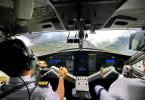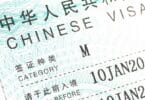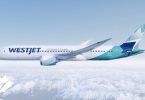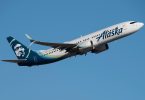Asian airlines are bracing gloomy times, despite their relative stronger position than their American or European counterparts. In Asia, competition remains effectively less developed than in Europe or the USA as many governments like China PRC, Japan, Korea, Indonesia or Vietnam continue to protect their airlines. But this time, Export-oriented Asia feels also the pain.
According to latest data from Association of Asia Pacific Airlines (AAPA), the first four months of 2009 saw international passengers traffic plunge by 9.6 percent compared to the same period of last year. All over Asia, airlines axed flights, reduced frequencies and lay-off staff. However, these measures do not seem enough to withstand the current storm.
However, airports and governments begin to step-in to consolidate the sector and help ailing airlines. Chinese and Japan main carriers have already asked their respective government for help.
In China, the air transport sector lost over US$ 277 million in 2008. On May 13, China Eastern confirmed to have received a government cash injection of US$290 million. “The money will reduce the financial strain we faced,” said Liu Jiangbo, a vice president of the parent company China Eastern Air Holding Co, according to a statement.
Air China’s Chairman Kong Dong has also reportedly asked in March for a cash injection of some US$440 million with China Southern begging the government for some US$330 million.
Among recent measures taken to stimulate traffic is the opening up of air routes between Taiwan and Mainland China after half a century of interruption. Started by the end of last year with some 100 services per week, Chinese and Taiwanese negotiators recently agreed to expand the agreement to 270 weekly services linking up to 27 cities in China and 3 airports in Taiwan on a regular basis. It would help to generate a new flow of three to five million passengers per year across the Taiwan Straits.
In Japan, the government has already indicated its willingness to provide low-interest loans to Air Nippon Airways and Japan Air Lines (JAL), if necessary, through its financing instrument, the Development Bank of Japan (DBJ). JAL is looking for a US$2 billion loan. The Scheduled Airlines Association has recently proposed to the Japanese Ministry of Transport a series of reforms to lower costs of flying to and from the country. It would include a reduction in landing fees and airport charges as well as lifting slot restrictions at major airports. The opening of two runways at both Tokyo Haneda and Narita airports and a new airport in Ibaraki, 100 km North of Tokyo, next year will help to reinvigorate air markets by introducing more competition.
Japanese authorities have already shown signs of flexibility. Cebu Pacific, the only foreign low-cost carrier allowed so far in Japan, recently secured the approval of Japan Civil Aviation Board to completely remove surcharges for its Manila-Osaka route, translating then into a fare reduction of over 45 percent.
Airports have also launched various incentive schemes to retain business. Singapore’s Changi Airport has been the quickest to react. In December 2008, the Civil Aviation Authority of Singapore (CAAS) decided to extend its “Air Hub Development Fund,” adding in February another US$50 million for various commercial measures. With a budget of US$138 million, the fund now provides discount of 20 percent on rents as landing fees’ rebate was increased from 15 percent to 25 percent. The CAAS works also with the International Civil Aviation Organization (ICAO) to reorganize air traffic from Europe passing over the Bay of Bengal in an attempt to reduce traffic congestion and consequently costly delays. The CAAS estimates that the new traffic management system will help to save the airlines some US$30 million in fuel consumption.
Despite helps, traffic shrunk in Singapore by some 12 percent over the first quarter of 2009. More worrying, the airport has lost over the last three years a high number of European carriers including prestigious names such as SAS Scandinavian Airlines and, since early April, Swiss.
By comparison, Hong Kong Airport Authority can rather be qualified as shy with a relief package of US$58 million to assist airlines and other operators whose business at Hong Kong International Airport (HKIA) has been adversely affected by the global economic downturn. The relief package comprises a 10 percent reduction in landing and parking fees for airlines and US$32.5 million interest-free, deferred payments.
In Thailand, Airports of Thailand (AoT), the authority managing Bangkok, Chiang Mai, Phuket and Hat Yai, saw traffic decrease by 16 percent from January to April. At Bangkok International airport, traffic tumbled by 11.5 percent. Load factors have lost up to 30 points compared to last year as Thailand has been plagued by political instability since last autumn. AoT has then decided to slowdown traffic’s erosions with new incentives to keep airlines operating. On April 23, AoT board of directors reduced landing fees by another 10 percent starting May 1 until the end of the year. From now, airlines will enjoy a 30 percent discount instead of a 20 percent rebate available since February. Parking fees for aircraft will also be waived until year-end.
AOT president Serirat Prasutanond told the Bangkok Post, AoT could introduce further measures to help airlines. For 2009, AoT expects passengers passing through its airports to fall by about 15 percent.
Even Vietnam’s Civil Aviation Authorities have decided to react. They recently implemented a series of tax deductions, including deferring income tax payment. In a bid to protect Vietnam carriers – and especially national carrier Vietnam Airlines- the Civil Aviation Authority of Viet Nam (CAAV) will not license any new airlines until 2015 for the official motive of limited airport facilities and a lack of skilled staff. Currently, five airlines are registered in the country. They are Vietnam Airlines, Jetstar Pacific, VietJet Air, Indochina Airlines and Mekong Airlines.






















